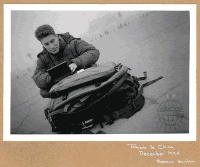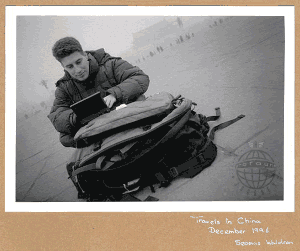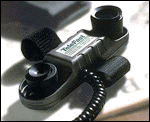|

Overview
 The PC110 is an ideal tool for
creating Web pages when away from the office, or as a high powered portable games machine,
during those long train and plane journeys. When travelling, you don't want to carry a
laptop with you, but a PalmTop is small enough to carry in a coat pocket or in your travel
bag. The PC110 is an ideal tool for
creating Web pages when away from the office, or as a high powered portable games machine,
during those long train and plane journeys. When travelling, you don't want to carry a
laptop with you, but a PalmTop is small enough to carry in a coat pocket or in your travel
bag.
Index
Publishing Web pages in the
field
To create web pages in the field, ie. in remote locations, be it on an aeroplane on in
a remote jungle retreat, you need to meet a minimum criteria.
In my view, you need to be able to contact the outside world through e-mail (at the
very least, so as somebody else can publish the web pages for you) and to be able to take
photographs and transfer them in a timely fashion to your computer. With just this minimum
criteria, you will be able to create quality web pages in the field and publish them to
the web.
More on this during Field Test 2 (see below).
Extend life - Build a battery
pack
How do you extend the battery life of your PC110? Well, there are two or three
options. You can buy several batteries for your palmtop, charge them all up and then swap
them around as needed. You could also buy yourself a solar power generator, or finally,
you can build your own battery pack.
To build the battery pack, you need just a few items :
- Two X Holder for 4 "D" Batteries
- One X Coaxial Power Plug (5,5 mm D.Ext 2,1 mm D.Int)
- One X Sony Plug Adaptor, 4,75 mm
- Eight X "D" cell batteries (re-chargeable or otherwise)
Simply wire the two battery holders together, leaving just two wires comming from them.
Wire these into the coaxil power plug (if you wire then in the wrong way round (I know
this sounds obvious), you will get no power into your PC110). Insert the plug adaptor into
the PC110 and the Battery plug into this and away you go!
I have been told that 8 "D" cells will provide 15 hours 38 minutes of
power. I have not tested this, so I don't know if this is true or not. The only
problem you will have when traveling with this unit is that it does rather look like a
bomb.....;-)
In the near future, I will attempt to draw a wiring diagram for this unit. It is
dead simple though.
First field test - China, December
1996

Using my PC110 in Tiannanman Square
- Peking, December 1996
|
What a disaster this was! The theory was sound, but it just didn't work.
So, what did I try to do? Objective : Send some e-mail from China, NOT using
Windows, ie running everything from Dos. The reason for this was that for "a profound
journey", I will need to stick a PCMCIA modem/satellite transiever into the slot that
my hard disk currently occupies, therefore everything needs to be DOS based. |
My solution was simple, use DosCIM to connect to Compuserve and then send my e-mail.
Why didn't it work? Well, first of all, there is no access number for Compuserve in China,
therefore you need to go through a 'broker' and this costs $$$$. Before I could
even make a connection, the Chinese power socket blew up my power cable. The phones were
all hard wired and then the batteries ran down.
If I had had more time, I would have been able to open a Chinese Internet account in
Beijing and used that - however I didn't take my floppy disk drive OR my docking station
with me, so even that solution would not have worked for me at the time.
Conclusion
- Use a local access provider if you can OR subscribe to a truely Global Internet Service.
- Don't rely on plugging your PC110 directly into the phone line of your hotel.
Second field test - Africa, July
1997
 I joinined the Over Africa
expedition, to provide remote telecommunications. I joinined the Over Africa
expedition, to provide remote telecommunications.
Objective : Have e-mail and Web connectivity. On the PC110, this will be DOS
based, on the laptop, this can be Windows based. To achieve these objective, I propose
three things.
- For connectivity software, use the new WebBoy DOS
browser/E-Mail from IBM.
- Use IBM Global Network for internet access.
 Use an acoustic coupler supplied by TeleAdapt Ltd to allow connection to any telephone. Use an acoustic coupler supplied by TeleAdapt Ltd to allow connection to any telephone. - Use solar technology to power the equipment.
Well, I flew out to Banjul in The Gambia on July 19th 1997. With me was my now
faithfull travel companion - my PC110, a GPS, acoustic coupler, a not quite installed
version of WebBoy and my snowboard.
To say that things did not go well was an understatement. The bottom line was that it
was impossible to get a clean telephone line. The only access to telephones are through
local GamTel offices (GamTel being the national telecoms providor). Connecting PC110 to
acoustic coupler and attaching to phone should have worked, but guess what? The
charging mechanism sends a very load click follwed by a blank on the line, my comms
software didn't have a chance. I didn't use WebBoy as at that time it was not fully
configured and I needed somebody to translate some more Japanese for me, but I did use
Ameol, an excellent email package for use with the British CIX online service.
On the Radio - "The Works",
BBC World Service, August 1997
 Between the 9th and 16th of August, "The Works"
was broardcast worldwide on the BBC World
Service. This edition, Week 32, I was the studio guest talking about the travelling I
do and the technology I employ. The BBC World Service is the largest Radio station in the
world and has an audience of 140 million world wide. Between the 9th and 16th of August, "The Works"
was broardcast worldwide on the BBC World
Service. This edition, Week 32, I was the studio guest talking about the travelling I
do and the technology I employ. The BBC World Service is the largest Radio station in the
world and has an audience of 140 million world wide.
Shortly I will have audio of that interview here.
Third/Fourth field test - Hungary,
August/September 1997
 The third field test was in August 1997,
departure to Budapest, Hungary was on August 21. The trip will supposed to involve
traversing from Hungary to the United Kingdom in a "combi" van. Data
communication was to be attempted using WinCim/DosCim attached to a telephone using an
acoustic coupler supplied by TeleAdapt. What
happend was absolutely typical, I had a total failure in luck. I managed to get to
Hungary, I even used my palmtop for viewing reference material I had previously
downloaded, however, the "combi-van2 had blown-up in Austria, so we went for a
holiday instead, returning a few days later by plane. The third field test was in August 1997,
departure to Budapest, Hungary was on August 21. The trip will supposed to involve
traversing from Hungary to the United Kingdom in a "combi" van. Data
communication was to be attempted using WinCim/DosCim attached to a telephone using an
acoustic coupler supplied by TeleAdapt. What
happend was absolutely typical, I had a total failure in luck. I managed to get to
Hungary, I even used my palmtop for viewing reference material I had previously
downloaded, however, the "combi-van2 had blown-up in Austria, so we went for a
holiday instead, returning a few days later by plane.
However, the fourth field test was an absoute result. After a few days partying, I
traveled through Hungary, Austria and Germany. I finally hit upon a combination of
software and hardware that worked well. I used a global internet access account from (now defunct) IBM global Network,which had POPs in nearly every country you can think of,
and Ameol from CIX.
Communications on the move, total success, September 1998
For three weeks in September 1998, I was in the Burgandy region of France. Quiet, out
of the way, noisest thing - the local duck. With a modem upgraded PC110, Ameol, IBM Global
Internet, my Telefast acoustic coupler a telephone card and telephone box, I was able to
upload/download my email and surf the web with absolutely no problems at all. This is how
it should be. Nothing to report other than, total success.
Entertainment on the move
So, you don't want to use your PC110 all the time for work? How about playing some
games. Well, first of all, there is the game in Personaware itself (it's just called
"Game"). Once you get into it, it is fiendishly addictive and difficult.
However, what do you do if you really want to play a game?
DOOM what else? Get it cranked up on
your harddisk, get volume up and play it on the underground when the guy next to you has
his walkman blaring too loudly. Ha! Revenge is sweat
But Doom has to be played on your Hard Disk. what do you do is you want to play games
for more than and hour? Well, you have to run your game from the internal flash card.
Unfortunately, you have to run your OS and probably PersonaWare as well. what do you do?
Well, so far, I've found the best solution is to have a ZX Spectrum (in the USA
this was called a Timex) emulator and then a handfull of games (each of these only take up
about 48k). Your'e not going to get Doom, but there are quite literally thousands of games
out there and a huge number of them are superb.
|